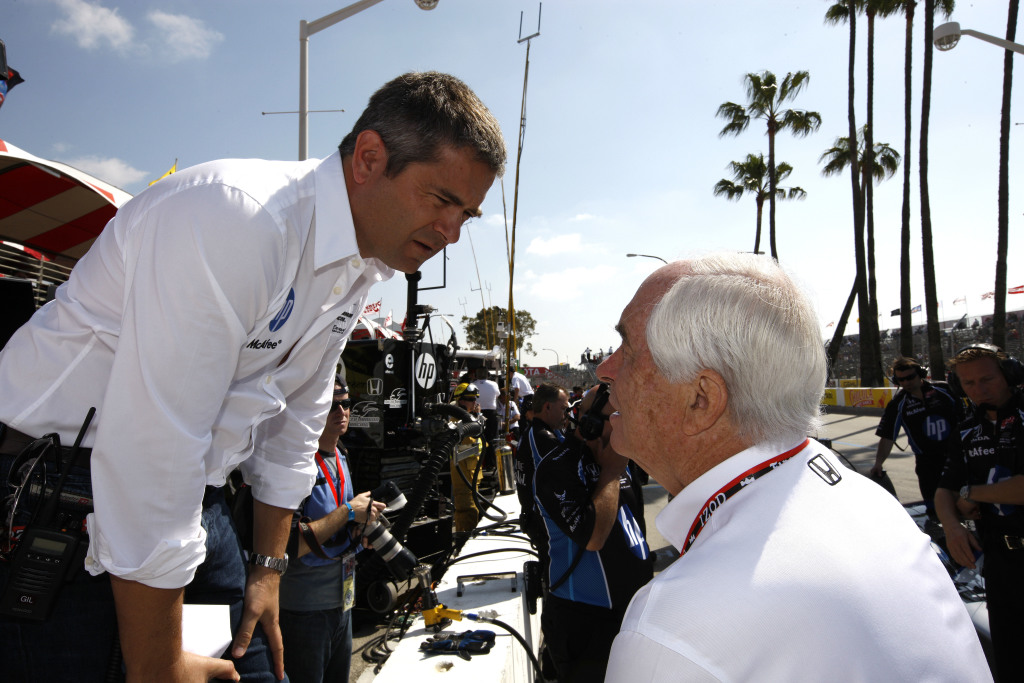The first image that comes to mind of Gil de Ferran is the impressive amount of mischief contained in the corners of his mouth. It’s where that wry smile was formed.
He’d see you from afar and one side of his face would react, almost involuntarily. It couldn’t be helped or stopped. And this wasn’t a smile where both sides rose uniformly; with de Ferran, it was usually a raised corner and a raised eyebrow, signals both that something funny — and at my expense — was on the way.
“I see you’re eating well,” was a favorite line he’d uncork once he got within earshot. And I loved it.
Such things were never said with malice. Not with one of the kindest people to grace our sport. With de Ferran, there was an expectation that any of the grief he would give would be returned, and that’s where his playful side — the roots of that mischievous smile — made it hard not to love the professorial Brazilian.
As a community, we’ve been shaken by de Ferran’s death. This has been a punch to the soul.
Taken at 56, his relative youth was the first factor that was nigh on impossible to process. Once his loss was accepted, the grand place he held within so many people in the sport — as a friend, confidant, and fountain of wisdom — became the next aspect to mourn. There’s been rejoicing, as well.
An unfathomable amount of appreciation and gratitude has been expressed for the two-time CART IndyCar Series champion, Indianapolis 500 winner, sports car team owner, sporting director and advisor to Formula 1 teams, and consultant and visionary whose incredible blend of technical and interpersonal skills enriched every racing organization he touched. His unwavering dedication to his wife Angela and the raising of their kids Anna and Luke is another area where he served as a massive influence to others in our busy sport.
And in that spirit of giving de Ferran his flowers, a number of his closest friends, teammates, colleagues, and more came together to share their thoughts about the man in ways that reveal the immense depth and humanity.
Here’s a collection of tales about Gil de Ferran, in both written and audio form. I hope you enjoy.
Randy Bernard, IndyCar CEO, 2010-12
The loss of Gil de Ferran hits me particularly hard. Gil was far too young to pass away and he was definitely someone you loved once you met him. He was a true gentleman and a class act.
I selected Gil to be on my ICONIC committee at IndyCar to help develop the car for the future. Gil was very passionate about this and Gil, Tony Purnell and I toured Europe meeting with car manufacturers and F1 teams. It was quite a grueling trip, but so worth it. We had several goals; first, to see if any manufacturers were interested in coming to IndyCar since we only had one powertrain with Honda at the time.
We were wanting to talk with CEOs to determine the fuel source of the future and we quickly learned every manufacturer had their own ideas — natural gas, diesel, ethanol… We also wanted to directly hear from them about what would excite them in racing to possibly move into our series. Gil was a racing legend, so the time and attention they gave us because of him was something I will never forget. I have two memories that stand out during that time which I think about often.
We were in Verano de Melegari, Italy, meeting with Gian Paolo Dallara, a legend in developing race cars. Mr. Dallara was also engineering cars like Bugatti, Maserati and Lamborghini. He was honored to have Gil at his headquarters and first we spent some time in Mr. Dallara’s simulator that he was partnered on with Ferrari. Then he proceeded to give us a very private tour showing us cars he was developing. One in particular was a street car he was building that he wanted to call “Dallara.” There was only one of them in the world and didn’t even have its skin on yet. It was a very powerful car and Gil was like a kid in a candy store talking about it with Mr. Dallara.
Mr. Dallara asked his team to move it to his private racetrack across the road because he wanted Gil to drive it. Gil was elated! This was like asking an astronaut if he wanted to go to space. We went across the road and Mr. Dallara asked if I wanted to ride shotgun with Gil, and of course I wanted to. We put on our race suits and Gil took it out on the track for four or five laps. He came back in and needed to put some tape on his helmet as a visor to keep the sun out of his eyes.
We took it back out and after four or five more laps, he looked over at me with a thumbs-up and pounced on it. We made a couple more laps before something went terribly wrong. We started spinning out of control until we hit the wall! Yes, we did a lot of damage to the car while Mr. Dallara watched. Gil was so apologetic, but Mr. Dallara just chuckled. You could see he had so much appreciation for Gil and not another word was ever said about it. On the other hand, I brought it up often!
The second memory was after this exhausting trip, and months later after every manufacturer had turned us down, we only had one left: GM. We really didn’t have high expectations with this meeting due to the major embarrassment of the U.S. government’s bailout of the auto industry. Gil and I fly up to Detroit and go to the very top floor of GM’s headquarters. I remember it like it was yesterday, taking that elevator ride to the top, feeling like we know the answer before the meeting even begins, especially from all the rejection Gil and I had heard.
We were meeting with the president of GM, Mark Reuss. We made our pitch to Mark and we were waiting for the “We can’t afford it” or “We just aren’t interested,” when Mark says, “We are in. With one promise — you need to bring a race back to Belle Isle.” We couldn’t believe what we heard. I felt like crying right there. We all shook hands and walked back to the elevator in silence. Once that elevator door shut, we looked at each other and started dancing and hugging each other like we had won the lottery.

Gil was a special individual that you were drawn to above and beyond his legacy of racing — his passion for life, his demeanor of always being willing to listen. I would never want to take anything away from any one individual that was on that ICONIC committee, as every single person contributed so much time and value. But I am confident that car would have never had seen the light of day without the passion of Gil and his vision. He never wanted the limelight, maybe because he knew the owners would want my head on the cutting block regardless, but anyone that knows Gil knew that was just him.
Although I left the racing world almost 10 years ago, I had many great memories and had the privilege to work with some of the greatest, and Gil de Ferran was one of those and made this cowboy feel welcome and appreciated. I know the racing world mourns for the loss of him as he was a true ICON.
Scott Dixon, CART IndyCar Series and Indy Racing League rival from 2001-03, de Ferran Motorsports American Le Mans Series Acura teammate, 2008-09
With Gil, one, is his off-track presence, right? Always super engaging, not like some people who can be quite loud. He always had a calmness to him as well. Super easy to talk to, super approachable. You don’t see that too often in racing, especially with the stressful weekends and all that’s going on. Even in the early years when he was dominating championships, and winning 500s. You don’t always see that side from people.

Throughout my career, even when I was looking at doing different things with different teams, Gil was always somebody to talk to because I always knew that he’d seen a lot in many different formulas as well. Probably the most fun I had with him was obviously doing the LMP2 and then LMP1 projects with him and [Simon] Pagenaud.
What always fascinated me with Gil was that he had the racing thing, but it was always the other projects that he was working on; he was relentless. Pushing boundaries and you even see that with Formula E, and whether it was with Honda in Formula 1 or with McLaren lately. But what was nice about Gil, too, is he flew under the radar. He didn’t feel like he was one of those guys that had to always promote himself.
I remember when we were looking at British schooling for our kids, I called Gil just to say, “Hey, what did you guys do with schooling?”, and he was like, “We did boarding school and I wasn’t used to that.” He said when he dropped the kids off to boarding in England, “The only person crying was myself, you know, sitting in a pile, crying at the boarding school as the kids just walked off and said, ‘See you later.’” I feel like that really summed up Gil just in that kind of that moment he had sending his kids off for school.
I don’t think I’ve really come across anyone like him in our sport.






